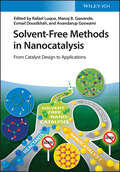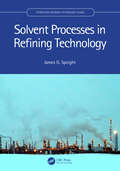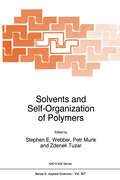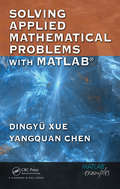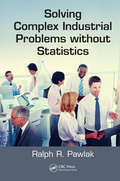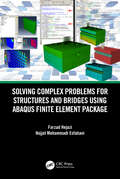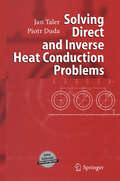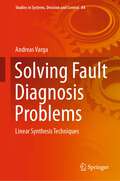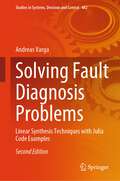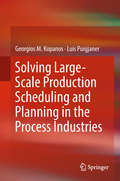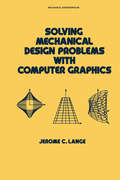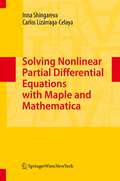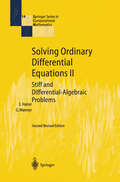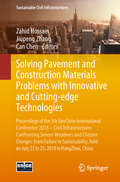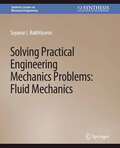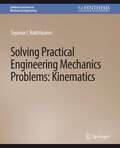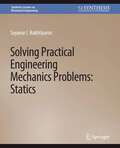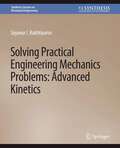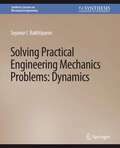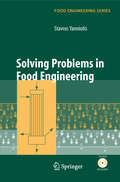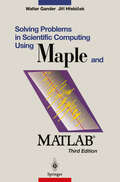- Table View
- List View
Solvent-Free Methods in Nanocatalysis: From Catalyst Design to Applications
by Rafael Luque Manoj B. Gawande Esmail Doustkhah Anandarup GoswamiSolvent-Free Methods in Nanocatalysis Discover solvent-free approaches for the synthesis of nanocatalysts as well as various catalytic transformations in this unique one-stop resource Solvent-free methods have attracted wide attention in organic synthesis and catalysis as a promising approach towards “greener” and more sustainable chemical transformations. In this regard, nanocatalysis has seen particular growth in recent years. Solvent-Free Methods in Nanocatalysis gives an in-depth overview of nanocatalysts and their catalytic applications using solvent-free methods. After a brief introduction, it covers various synthetic techniques for the preparation of nanocatalysts and supports using solvent-free methods, e.g. ball-milling, microwave- and plasma-assisted methods. The book discusses in detail different catalyst classes, such as metal oxides, doped and functionalized nanocarbons, as well as nitride- and silica-based materials to help researchers to understand the efficiency and nature of these catalysts/supports based on their chemical structure. In the book readers will also find: A brief account of the history, challenges, and recent advances in the field Detailed discussion of advantages and disadvantages of solvent-free techniques for nanocatalyst preparation Treatment of important solvent- and catalyst-free organic transformations (i.e. oxidation, coupling and multicomponent reactions) A chapter on supported ionic liquids for solvent-free catalysis Written by leading researchers in the field, Solvent-Free Methods in Nanocatalysis is a useful reference for researchers and students working in organic synthesis, catalysis, and nanomaterials science.
Solvent Processes in Refining Technology (Petroleum Refining Technology Series)
by James G. SpeightThis book focuses on the various solvent processes that are used in crude oil refineries. It presents the differences between each type of process and discusses the types of feedstock that can be used for the processes. This accessible guide is written for managers, professionals, and technicians as well as graduate students transitioning into the refining industry. . Key Features: • Describes the various steps that are necessary for the solvent treatment of various feedstocks in crude oil refineries. Brings the reader up to date and adds more data. Provides an extensive glossary. Considers next-generation processes and developments.
Solvent Processes in Refining Technology (Petroleum Refining Technology Series)
by James G. SpeightThis book focuses on the various solvent processes that are used in crude oil refineries. It presents the differences between each type of process and discusses the types of feedstock that can be used for the processes. This accessible guide is written for managers, professionals, and technicians as well as graduate students transitioning into the refining industry. . Key Features: • Describes the various steps that are necessary for the solvent treatment of various feedstocks in crude oil refineries. Brings the reader up to date and adds more data. Provides an extensive glossary. Considers next-generation processes and developments.
Solvents and Self-Organization of Polymers (NATO Science Series E: #327)
by S. E. Webber Petr Munk Zdenek TuzarSolvents and Self-Organization of Polymers brings together scientists who are experts in macromolecular synthesis, the physical chemistry and the physics of polymer self-organization. The book also contains experimental results and methods, analytical theory and computer simulations. While the work concentrates on problems of basic science, such practical applications as pharmacology are not excluded. The broad cross-fertilization between these areas makes the book a fascinating and masterly survey of the area.
Solving Applied Mathematical Problems with MATLAB (PDF)
by Dingyu XueThis textbook presents a variety of applied mathematics topics in science and engineering with an emphasis on problem solving techniques using MATLAB. The authors provide a general overview of the MATLAB language and its graphics abilities before delving into problem solving, making the book useful for readers without prior MATLAB experi
Solving Complex Industrial Problems without Statistics
by Ralph R. PawlakPresenting: Problem Solving Sans Statistics Enhance your problem-solving skills, and improve your company’s profitability using the methods outlined in Solving Complex Industrial Problems without Statistics. Introducing a process that involves working through problems and solutions without relying on complicated statistical design or analysis, this book pulls away from data-driven thinking and provides the problem solver with a new way of solving problems. Utilizing techniques that have been applied in facilities throughout the U.S., Canada, Italy, China, and Hong Kong, it demonstrates the use of process and problem differences and similarities, and provides a better understanding of analogous comparisons. The book incorporates visual analysis tools and problem examples in a format that facilitates comprehension and learning, presents novel concepts that do not require numbers or statistics, and provides a better understanding of the solution system/process overall. Each chapter presents new information, as well as case studies that include: Different problem situations Short histories detailing the operation, condition, and circumstances that were present at the time of each study Photographs, sketches, or tables with simple explanations to describe the circumstances, conditions, and the actions taken Methods of solution in rudimentary form Chapter summaries to review important mechanisms and workings Final summaries to tie together the important methods and techniques that facilitate easy problem solutions Solving Complex Industrial Problems without Statistics provides valuable insight into the solution of complex quality and manufacturing problems, without the use of statistics, and is essential to anyone involved in quality, control, problem-solving activities, or total quality management.
Solving Complex Industrial Problems without Statistics
by Ralph R. PawlakPresenting: Problem Solving Sans Statistics Enhance your problem-solving skills, and improve your company’s profitability using the methods outlined in Solving Complex Industrial Problems without Statistics. Introducing a process that involves working through problems and solutions without relying on complicated statistical design or analysis, this book pulls away from data-driven thinking and provides the problem solver with a new way of solving problems. Utilizing techniques that have been applied in facilities throughout the U.S., Canada, Italy, China, and Hong Kong, it demonstrates the use of process and problem differences and similarities, and provides a better understanding of analogous comparisons. The book incorporates visual analysis tools and problem examples in a format that facilitates comprehension and learning, presents novel concepts that do not require numbers or statistics, and provides a better understanding of the solution system/process overall. Each chapter presents new information, as well as case studies that include: Different problem situations Short histories detailing the operation, condition, and circumstances that were present at the time of each study Photographs, sketches, or tables with simple explanations to describe the circumstances, conditions, and the actions taken Methods of solution in rudimentary form Chapter summaries to review important mechanisms and workings Final summaries to tie together the important methods and techniques that facilitate easy problem solutions Solving Complex Industrial Problems without Statistics provides valuable insight into the solution of complex quality and manufacturing problems, without the use of statistics, and is essential to anyone involved in quality, control, problem-solving activities, or total quality management.
Solving Complex Problems for Structures and Bridges using ABAQUS Finite Element Package
by Farzad Hejazi Hojjat Mohammadi EsfahaniThis book aims to present specific complicated and puzzling challenges encountered for application of the Finite Element Method (FEM) in solving Structural Engineering problems by using ABAQUS software, which can fully utilize this method in complex simulation and analysis. Therefore, an attempt has been to demonstrate the all process for modeling and analysis of impenetrable problems through simplified step by step illustrations with presenting screenshots from software in each part and also showing graphs. Farzad Hejazi is the Associate Professor in the Department of Civil Engineering, Faculty of Engineering, University Putra Malaysia (UPM), and a Senior Visiting Academic at the University of Sheffield, UK. Hojjat Mohammadi Esfahani,an expert on Finite Element Simulation,has more than 10 years of experience in the teaching and training of Finite Element packages, such as ABAQUS.
Solving Complex Problems for Structures and Bridges using ABAQUS Finite Element Package
by Farzad Hejazi Hojjat Mohammadi EsfahaniThis book aims to present specific complicated and puzzling challenges encountered for application of the Finite Element Method (FEM) in solving Structural Engineering problems by using ABAQUS software, which can fully utilize this method in complex simulation and analysis. Therefore, an attempt has been to demonstrate the all process for modeling and analysis of impenetrable problems through simplified step by step illustrations with presenting screenshots from software in each part and also showing graphs. Farzad Hejazi is the Associate Professor in the Department of Civil Engineering, Faculty of Engineering, University Putra Malaysia (UPM), and a Senior Visiting Academic at the University of Sheffield, UK. Hojjat Mohammadi Esfahani,an expert on Finite Element Simulation,has more than 10 years of experience in the teaching and training of Finite Element packages, such as ABAQUS.
Solving Direct and Inverse Heat Conduction Problems
by Jan Taler Piotr DudaThis book presents a solution for direct and inverse heat conduction problems, discussing the theoretical basis for the heat transfer process and presenting selected theoretical and numerical problems in the form of exercises with solutions. The book covers one-, two- and three dimensional problems which are solved by using exact and approximate analytical methods and numerical methods. An accompanying CD-Rom includes computational solutions of the examples and extensive FORTRAN code.
Solving Fault Diagnosis Problems: Linear Synthesis Techniques (Studies in Systems, Decision and Control #84)
by Andreas VargaThis book addresses fault detection and isolation topics from a computational perspective. Unlike most existing literature, it bridges the gap between the existing well-developed theoretical results and the realm of reliable computational synthesis procedures. The model-based approach to fault detection and diagnosis has been the subject of ongoing research for the past few decades. While the theoretical aspects of fault diagnosis on the basis of linear models are well understood, most of the computational methods proposed for the synthesis of fault detection and isolation filters are not satisfactory from a numerical standpoint. Several features make this book unique in the fault detection literature: Solution of standard synthesis problems in the most general setting, for both continuous- and discrete-time systems, regardless of whether they are proper or not; consequently, the proposed synthesis procedures can solve a specific problem whenever a solution existsEmphasis on the best numerical algorithms to solve the synthesis problems for linear systems in generalized state-space form (also known as descriptor systems)Development of general synthesis procedures relying on new computational paradigms, such as factorization-based design based on filter updating techniques and nullspace-based synthesisAvailability of a comprehensive set of free accompanying software tools for descriptor systems, which allows readers to easily implement all synthesis procedures presented in the book and ensures that all results are reproducible This book is primarily intended for researchers and advanced graduate students in the areas of fault diagnosis and fault-tolerant control. It will also appeal to mathematicians with an interest in control-oriented numerics.
Solving Fault Diagnosis Problems: Linear Synthesis Techniques with Julia Code Examples (Studies in Systems, Decision and Control #482)
by Andreas VargaThe goal of this new edition is the same as for the first edition ”to address the fault detection and isolation topics from a computational perspective“, by covering the same important aspects, namely, (1) providing a completely general theoretical treatment of fault and model detection problems for linear time-invariant systems; (2) presenting the best suited numerical approaches to solve the specific computational problems; (3) providing supporting software to solve the analysis and filter synthesis problems. In this second edition, the changes in the theoretical presentation are minor and all known errors and typos have been corrected. The major difference to the first edition is in the underlying computational support, which is now based on software developed in a relatively new language called Julia. The presentation of synthesis procedures and examples is similar to the first edition, but it is now interlaced with Julia codes which can be used to reproduce all computational examples and figures presented in the book. An Appendix has been added to cover some basic issues related to using Julia and the new FaultDetectionTools and DescriptorSystems packages.
Solving Large-Scale Production Scheduling and Planning in the Process Industries
by Georgios M. Kopanos Luis PuigjanerThis book presents a number of efficient techniques for solving large-scale production scheduling and planning problems in process industries. The main content is supplemented by a wealth of illustrations, while case studies on large-scale industrial applications, ranging from continuous to semicontinuous and batch processes, round out the coverage.The book examines a variety of complex, real-world problems, and demonstrates solutions that are applicable to scenarios and countries around the world. Specifically, these case studies include:• the production planning of the bottling stage of a major brewery at the Cervecería Cuauhtémoc Moctezuma (Heineken Int) in Mexico;• the production scheduling for multi-stage semicontinuous processes at an ice-cream production facility of Unilever in the Netherlands;• the resource-constrained production planning for the yogurt production line at the KRI KRI dairy production facility in Greece; and• the production scheduling for large-scale, multi-stage batch processes at a pharmaceutical batch plant in Germany.In addition, the book includes industrial-inspired case studies of:• the simultaneous planning of production and logistics operations considering multi-site facilities for semicontinuous processes; and• the integrated planning of production and utility systems in process industries under uncertainty.Solving Large-scale Production Scheduling and Planning in the Process Industries offers a valuable reference guide for researchers and decision-makers alike, as it shows readers how to evaluate and improve existing installations, and how to design new ones. It is also well suited as a textbook for advanced courses on production scheduling and planning in industry, as it addresses the optimization of production and logistics operations in real-world process industries.
Solving Mechanical Design Problems with Computer Graphics
by Jerome LangeThis book acquaints the reader with interactive computer graphics and how they are being used in the analysis of mechanical design problems. It covers four mechanical design topics: the graphics model, mass properties, stress and strain, and kinematic and kinetic analysis.
Solving Mechanical Design Problems with Computer Graphics
by Jerome LangeThis book acquaints the reader with interactive computer graphics and how they are being used in the analysis of mechanical design problems. It covers four mechanical design topics: the graphics model, mass properties, stress and strain, and kinematic and kinetic analysis.
Solving Nonlinear Partial Differential Equations with Maple and Mathematica
by Inna Shingareva Carlos Lizárraga-CelayaThe emphasis of the book is given in how to construct different types of solutions (exact, approximate analytical, numerical, graphical) of numerous nonlinear PDEs correctly, easily, and quickly. The reader can learn a wide variety of techniques and solve numerous nonlinear PDEs included and many other differential equations, simplifying and transforming the equations and solutions, arbitrary functions and parameters, presented in the book). Numerous comparisons and relationships between various types of solutions, different methods and approaches are provided, the results obtained in Maple and Mathematica, facilitates a deeper understanding of the subject. Among a big number of CAS, we choose the two systems, Maple and Mathematica, that are used worldwide by students, research mathematicians, scientists, and engineers. As in the our previous books, we propose the idea to use in parallel both systems, Maple and Mathematica, since in many research problems frequently it is required to compare independent results obtained by using different computer algebra systems, Maple and/or Mathematica, at all stages of the solution process. One of the main points (related to CAS) is based on the implementation of a whole solution method (e.g. starting from an analytical derivation of exact governing equations, constructing discretizations and analytical formulas of a numerical method, performing numerical procedure, obtaining various visualizations, and comparing the numerical solution obtained with other types of solutions considered in the book, e.g. with asymptotic solution).
Solving Ordinary Differential Equations II: Stiff and Differential-Algebraic Problems (Springer Series in Computational Mathematics #14)
by Ernst Hairer Gerhard WannerThe subject of this book is the solution of stiff differential equations and of differential-algebraic systems. This second edition contains new material including new numerical tests, recent progress in numerical differential-algebraic equations, and improved FORTRAN codes. From the reviews: "A superb book...Throughout, illuminating graphics, sketches and quotes from papers of researchers in the field add an element of easy informality and motivate the text." --MATHEMATICS TODAY
Solving Pavement and Construction Materials Problems with Innovative and Cutting-edge Technologies: Proceedings of the 5th GeoChina International Conference 2018 – Civil Infrastructures Confronting Severe Weathers and Climate Changes: From Failure to Sustainability, held on July 23 to 25, 2018 in HangZhou, China (Sustainable Civil Infrastructures)
by Zahid Hossain Jiupeng Zhang Can ChenThis book presents challenges in transportation engineering, recent developments and advancements in technologies, and design and construction using sustainable materials. The articles presented in this volume focus on fundamental investigations on various aspects of civil engineering materials and structures. The scope of this volume is the application of findings for solving problems in geotechnical, pavement, and transportation engineering using emerging techniques. Papers were selected from the 5th GeoChina International Conference 2018 on Civil Infrastructures Confronting Severe Weathers and Climate Changes Conference, held on July 23 to 25, 2018 in HangZhou, China.
Solving Practical Engineering Mechanics Problems: Fluid Mechanics (Synthesis Lectures on Mechanical Engineering)
by Sayavur BakhtiyarovFluid Mechanics is the study of liquid or gas behavior in motion or at rest. It is one of the fundamental branches of Engineering Mechanics, which is important to educate professional engineers of any major. Many of the engineering disciplines apply Fluid Mechanics principles and concepts. In order to absorb the materials of Fluid Mechanics, it is not enough just to consume theoretical laws and theorems. A student also must develop an ability to solve practical problems. Therefore, it is necessary to solve many problems independently. This book is a supplement to the Fluid Mechanics course in learning and applying the principles required to solve practical engineering problems in the following branches of Fluid Mechanics: Hydrostatics, Fluid Kinematics, Fluid Dynamics, Turbulent Flow and Gas Dynamics (Compressible Fluid Flow). This book contains practical problems in Fluid Mechanics, which are a complement to Fluid Mechanics textbooks. The book is the product of material covered in many classes over a period of four decades at several universities. It consists of 18 sets of problems where students are introduced to various topics of the Fluid Mechanics. Each set involves 30 problems, which can be assigned as individual homework as well as test/exam problems. The solution of a similar problem for each set is provided. The sequence of the topics and some of the problems were adopted from Fluid Mechanics by R. C. Hibbeler, 2nd edition, 2018, Pearson.
Solving Practical Engineering Mechanics Problems: Kinematics (Synthesis Lectures on Mechanical Engineering)
by Sayavur BakhtiyarovEngineering Mechanics is one of the fundamental branches of science which is important in the education of professional engineers of any major. Most of the basic engineering courses, such as mechanics of materials, fluid and gas mechanics, machine design, mechatronics, acoustics, vibrations, etc. are based on Engineering Mechanics course. In order to absorb the materials of Engineering Mechanics, it is not enough to consume just theoretical laws and theorems—student also must develop an ability to solve practical problems. Therefore, it is necessary to solve many problems independently. This book is a part of a four-book series designed to supplement the Engineering Mechanics courses in the principles required to solve practical engineering problems in the following branches of mechanics: Statics, Kinematics, Dynamics, and Advanced Kinetics. Each book contains 6-8 topics on its specific branch and each topic features 30 problems to be assigned as homework, tests, and/or midterm/final exams with the consent of the instructor. A solution of one similar sample problem from each topic is provided. This second book in the series contains six topics of Kinematics, the branch of mechanics that is concerned with the analysis of motion of both particle and rigid bodies without reference to the cause of the motion. This book targets undergraduate students at the sophomore/junior level majoring in science and engineering.
Solving Practical Engineering Mechanics Problems: Statics (Synthesis Lectures on Mechanical Engineering)
by Sayavur BakhtiyarovEngineering mechanics is one of the fundamental branches of science that is important in the education of professional engineers of any major. Most of the basic engineering courses, such as mechanics of materials, fluid and gas mechanics, machine design, mechatronics, acoustics, vibrations, etc. are based on engineering mechanics courses. In order to absorb the materials of engineering mechanics, it is not enough to consume just theoretical laws and theorems—a student also must develop an ability to solve practical problems. Therefore, it is necessary to solve many problems independently. This book is a part of a four-book series designed to supplement the engineering mechanics courses. This series instructs and applies the principles required to solve practical engineering problems in the following branches of mechanics: statics, kinematics, dynamics, and advanced kinetics. Each book contains between 6 and 8 topics on its specific branch and each topic features 30 problems to be assigned as homework, tests, and/or midterm/final exams with the consent of the instructor. A solution of one similar sample problem from each topic is provided. This first book contains seven topics of statics, the branch of mechanics concerned with the analysis of forces acting on construction systems without an acceleration (a state of the static equilibrium). The book targets the undergraduate students of the sophomore/junior level majoring in science and engineering.
Solving Practical Engineering Mechanics Problems: Advanced Kinetics (Synthesis Lectures on Mechanical Engineering)
by Sayavur BakhtiyarovEngineering Mechanics is one of the fundamental branches of science which is important for the education of professional engineers regardless of major. Most of the basic engineering courses, such as mechanics of materials, fluid and gas mechanics, machine design, mechatronics, acoustics and vibrations, etc., are based on the Engineering Mechanics course. In order to absorb the materials of Engineering Mechanics, it is not enough to just consume theorems and theoretical laws. A student also must develop an ability to solve practical problems. Therefore, it is necessary to solve many problems independently. The books in this series are designed as supplements to the Engineering Mechanics course and can be used to apply the principles required for solving practical engineering problems in the following branches of Mechanics: Statics, Kinematics, Dynamics, and Advanced Kinetics. Each book contains several (between 6 and 8) topics of the branch. Each topic has 30 problems to be assigned as homework, tests, and midterm/final exams with the consent of the instructor. A solution of one similar sample problem from each topic is provided. This fourth book in the series contains eight topics of Advanced Kinetics, which is the branch of Mechanics that is concerned with the analysis of motion of both particles and rigid bodies with reference to the cause of the motion. This book is targeted to undergraduate students of the junior/senior level as well as graduate students majoring in science and engineering.
Solving Practical Engineering Problems in Engineering Mechanics: Dynamics (Synthesis Lectures on Mechanical Engineering)
by Sayavur BakhtiyarovEngineering Mechanics is one of the fundamental branches of science that is important in the education of professional engineers of any major. Most of the basic engineering courses, such as mechanics of materials, fluid and gas mechanics, machine design, mechatronics, acoustics, vibrations, etc. are based on an Engineering Mechanics course. In order to absorb the materials of Engineering Mechanics, it is not enough to consume just theoretical laws and theorems—a student also must develop an ability to solve practical problems. Therefore, it is necessary to solve many problems independently. This book is a part of a four-book series designed to supplement the Engineering Mechanics courses in the principles required to solve practical engineering problems in the following branches of mechanics: Statics, Kinematics, Dynamics, and Advanced Kinetics. Each book contains 6-8 topics on its specific branch and each topic features 30 problems to be assigned as homework, tests, and/or midterm/final exams with the consent of the instructor. A solution of one similar sample problem from each topic is provided. This third book in the series contains seven topics on Dynamics, the branch of mechanics that is concerned with the relation existing between the forces acting on the objects and the motion of these objects. This book targets undergraduate students at the sophomore/junior level majoring in science and engineering.
Solving Problems in Food Engineering (Food Engineering Series)
by Stavros YanniotisThis easy-to-follow guide is a step by step workbook intended to enhance students' understanding of complicated concepts in food engineering. It also gives them hands-on practice in solving food engineering problems. The book covers problems in fluid flow, heat transfer, and mass transfer. It also tackles the most common unit operations that have applications in food processing, such as thermal processing, cooling and freezing, evaporation, psychometrics and drying. Included are theoretical questions in the form of true or false, solved problems, semi-solved problems, and problems solved using a computer. The semi-solved problems guide students through the solution.
Solving Problems in Scientific Computing Using Maple and MATLAB®
by Walter Gander Jiri HrebicekFrom the reviews: ".. An excellent reference on undergraduate mathematical computing."(American Mathematical Monthly)"... manuals for such systems (Maple and MATLAB) tend to use trivial examples, making it difficult for new users of such systems to quickly apply their power to real problems. The authors have written a good book to address this need. ... the book is worth buying if you want guidance in applying Maple and MATLAB to problems in the workplace..."(Computing Reviews)".. The presentation is unique, and extremely interesting. I was thrilled to read this text, and to learn the powerful problem-solving skills presented by these authors. I recommend the text highly, as a learning experience, not only to engineering students, but also to anyone interested in computation."(Mathematics of Computation)
